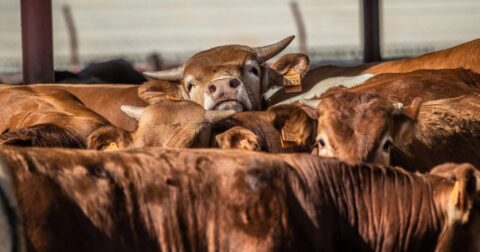Explainer
How Slaughterhouses Work: The Harsh Reality of Meat Production
Food•8 min read
Perspective
Many consumers believe conventional meat products are more natural than their lab-grown counterparts. What is "natural," however, is not always best.


Words by Bruno Decc
A clump of cloned cells obtained from cows sits inside a petri dish, soaking in a chemical solution of amino acids, hydrolysates, monosaccharides, or perhaps potassium. Visible only through a microscope, the cells are hard at work absorbing the molecules as fuel to replicate and grow new cells. Latex robot hands carefully transport the clump from the petri dish to the top of a veiny and transparent edible fibrous crust, which the growing biomass of cells completely envelopes over the course of a few hours. Voila! Meat is created without the use of animals, natural resources, or polluting byproducts.
Innovative food producers are developing highly artificial processes to make cultured meat and other products without relying on animal farming. In vitro cell culturing bypasses animal exploitation and slaughter to produce animal flesh, milk, eggs, and more. The field of cultured food and material production is still in its nascency, but many of its underlying technologies are rapidly approaching breakthroughs that may soon enable mass production. Under development by entrepreneurs and start-up companies, experimental techniques, like those utilizing bioreactors—biologically active mediums in which cells can grow—are scaling up with automation, better filtration systems, and wider end-product diversification. Globally, technologies are available to replace every product that is currently derived from animal farming with cloned, lab-grown versions.
Analysts predict that traditional meat’s market share could drop to as low as 40 percent in relation to synthetics over the next 20 years. Cultured meat (also known as “clean meat”) and other artificially-produced foods now include pulled oats, milk, honey, yogurt, kefir, kombucha, sauerkraut, pickles, miso, tempeh, canned tomatoes, canned beans, peanut butter, and even frozen vegetables. Lab culture technologies can also produce a wide range of non-edible materials, such as furs and wood, without relying on living plants or animals. Rapidly expanding in both variety and scale, artificial food and material production is on track to significantly displace traditional animal-based systems.
A societal switch from conventional to artificial foods and materials would benefit animals, humans, and the environment. Innovative artificial systems negate the need to produce meat and animal products by harming animals—globally, humans kill over 70 billion animals for food and 50 million more for their fur each year. Compared to “natural” meat, artificially-grown meat eliminates the public health risks associated with bacterial meat-borne illnesses, such as salmonella and E. coli; artificial meat production also greatly reduces the risk of spawning zoonotic diseases, like H1N1 “swine flu” and COVID-19, which are largely caused by exploiting animals and their habitats. Artificial meat is also free of both artificial growth hormones and super bug-spawning antibiotics that are commonly present in farmed meat. Replacing animal farming with artificial solutions would mitigate the ecological damage, including wildlife extinction and biodiversity collapse, caused by widespread animal ranching and factory farming. Animal agribusiness already occupies about 40 percent of Earth’s landmass and accounts for 75 percent of total global deforestation to date. Artificial food production can decouple production capacity from the demand for natural resources such as land, minerals, water, and oil. Scaling up artificial food and materials production is a compelling solution for the global community to address many intractable health, ethical, and scarcity concerns.
Despite cultured food’s significant potential benefits, the general public prefers to avoid “unnatural” interventions. A 2015 Meat Science report indicates that up to 84 percent of Europeans reject animal product alternatives because they perceive them as not natural. A 2018 Faunalytics study shows that less than 50 percent of people surveyed in Asia, Europe, and North America view cultured animal products as palatable, while other surveys reveal even bleaker figures ranging from 18 to 26 percent. The public tends to distrust foods perceived as “artificial,” potentially due to humans’ evolutionary tendency to avoid unfamiliar substances—an instinct that is less relevant in the modern age of food quality certifications.
Consumers’ food preferences have strong ideological motivations, too. Animal product consumption is strongly associated with virility, masculinity, and higher social class. Many consumers place fundamentally higher values on foods produced with little to no human interventions, largely believing that naturally-occurring products must be better for their health. Consumer distaste for artificial foods is closely related to chemophobia, which is the aversion to any chemical additives in products. A poor understanding of artificially-produced foods, coupled with evolutionary tendencies and societal biases, creates significant barriers to greater consumer acceptance of cultured foods.
The general public continues to believe that animal farming is a natural and sustainable process, despite ample evidence to the contrary. The 2018 Faunalytics study finds that about 80 percent of Americans do not perceive conventional meat as unnatural, instead considering it both acceptable and desirable. A 2019 survey finds that 50 percent of Americans believe that foods and materials produced “naturally”—including animal products—are more sustainable. Consumers prefer organic, traditional, and “fresh” foods because they believe that such foods are the most healthy, yet high consumption of “natural” farmed animal products is proven to increase the incidence of chronic diseases like Type 2 diabetes and heart disease. The dominating perception that animal agriculture is natural and therefore yields healthy foods is helping to propel animal products’ continued consumption globally.
The consumer preference for naturalness is likely restricting the cultured material sector’s progress. While artificial food production systems are proliferating, as are the associated companies’ market shares, this growth is potentially being limited by how consumers perceive these products. According to a 2017 study, only one-third of Americans are willing to eat in vitro meat regularly. As long as consumers strongly prefer naturalness, according to the 2015 Meat Science report, investors will continue to be relatively averse to financing the development of artificial materials and foods. Yet even with this counterpressure, the global cultured meat market is predicted to grow by 15.7 percent between 2025 and 2032. Naturalness preferences are constraining, but not entirely halting, a large-scale shift toward artificially-made products.
Globally, consumers are still more likely to reject animal product alternatives when their naturalness is questioned. Traditional animal product industries are attempting to use this consumer bias as a potent marketing tool. The dairy industry is currently lobbying for Congressional bills that would limit the use of the word “milk” to products containing animal secretions. The U.S. Food and Drug Administration, responding to industry pressure, proposed a rule in mid-2018 that would require products labeled as milk to consist of “lacteal secretion obtained by the complete milking of one or more healthy cows.” (Whether most dairy cows can be considered “healthy” is another matter altogether.) Animal farming groups, such as the U.S. Cattlemen’s Association, are petitioning the U.S. Department of Agriculture to remove cultured meat from its meat product category—a move that market research suggests would decrease cultured meat product sales. Trade associations such as Fur Europe and the International Fur Trade Federation are attempting to taint consumers’ perceptions of synthetic fur by criticizing its reliance on chemicals. Established animal-based businesses are wielding the consumer preference for naturalness in an attempt to maintain market dominance in the face of rising competition from alternatives.
Many consumers associate the concept of naturalness with healthiness and that of artificiality with unhealthiness. What is natural, however, is not always good. Some experts argue that natural, calorie-rich sweeteners such as honey and maple syrup may be less healthy for inactive people than human-created chemical sweeteners like aspartame and saccharin, which are nearly zero-calorie and present negligible cancer risks. Disasters such as volcano eruptions, hurricanes, tornadoes, and tsunamis are entirely natural—yet they inflict widespread damage on humans and animals alike. Societies can engineer artificial production systems with “goodness” and sustainability in mind, demonstrating that a system’s anthropogenic origins do not solely determine whether it is capable of functioning well and doing good on a long-term basis. Many of humans’ biases against artificiality stem from the assumptions that sustainability requires equilibrium between humans and ecosystems and that no anthropogenic intervention can produce a sustainable system. This mindset overly values the ways that smaller, non-industrialized populations of humans have historically interacted with ecosystems, and fails to account for the changing needs of our rapidly-multiplying species in the post-Industrial Revolution era. “Naturalness” often satisfies knee-jerk consumer preferences at the expense of the more tangible benefits that artificiality may offer.
Despite their many harmful impacts, the commodities produced by animal farming continue to be in high global demand, due in part to popular misconceptions about naturalness and artificiality. The resulting consumer misapprehension toward artificial products—exacerbated by marketing messages that reinforce a false dichotomy between naturalness and artificialness—muddles the discourse surrounding cultured processes and slows technological innovation. An updated and more nuanced understanding of naturalness in the public sphere may allow animal farming to be displaced, resulting in significant global progress on ethical, health, and environmental problems. Cultured products can enable a viable future in alignment with our technology-driven society—the only remaining obstacle is our own human bias.